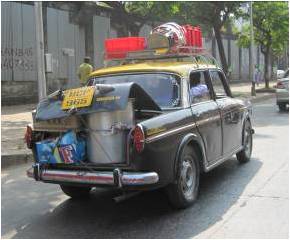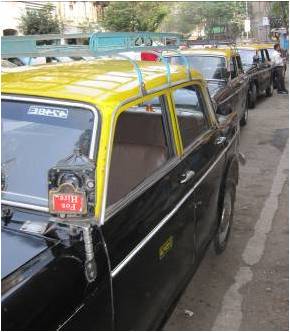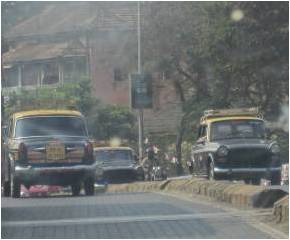Contribute
| Bombay's Workhorse - The Mumbaikar Taxicab |
Raj Melville
03/18/2010
We have been fortunate to visit our home, in Bombay, India, on a regular basis the past decade. With the dawn of the new century, India has been propelled onto an accelerated trajectory of growth. Each trip continues to assault the senses with changes in every direction. New buildings seem to spring out whole from formerly deserted land or shoehorned into the crazy quilt urban landscape. The acrid whiff of thousands of trucks, cars and two wheelers gets stronger every year. The continuous hum of traffic, the incessant honking adds to the background noise.
However among all the change there is one constant that an old Mumbaikar can relate to – the ubiquitous Fiat/Padmini taxicab. Over the decades as the city has grown and modernized, the fleet of taxicabs seems stuck in a different era. There are over 50,000 licensed black and yellow cabs in the city, yet almost all of them seem to be some variant of the basic Fiat cab manufactured over 50 years ago by Premier.
Walk down the street and you will see them waiting for a fare, their drivers proudly polishing the battered shell. The cars have been around so long that most of the original ornamentation has fallen off. There is not a trace of the make or model on any surface, but each vehicle is lovingly customized with quotes from their favorite movies or their personal god or goddess ensconced on their dashboard.
Traveling in one of them is an adventure. Flag one down, struggle to open the door and slide onto the bench seat, typically upholstered in some variant of gaudy velour. The meter, stuck in a time warp, still shows Rs. 1 as the initial fare. The interior is unrecognizable from the original having gone through several customized iterations. I once made the mistake of sitting in the front seat and almost had my head sliced off by the funky stereo unit that was affixed to the ceiling. Seat belts, though mandatory in the city, are unheard of in the Fiat taxi. Side view mirrors are a luxury and rearview mirrors barely serve any purpose on Bombay’s crowded streets. Air conditioning is unavailable and the only ventilation is by rolling down the window.
The Fiat/Padmini taxi is the all purpose workhorse for the city. Cruise down any thoroughfare and you will see a dozen different applications of the trusty platform. Over there a family of six somehow crams into the vehicle, with their shopping bags filling in the little remaining space. Down a ways I pass a moveable feast – a complete kitchen with pots, pans, and foodstuff – obviously a cook for hire on his way to cater a function.
Traveling across the city gives you time to contemplate since you are not going any where fast. For the longest time, I thought we lived really far away from the local beach since it took us over an hour to get there. Then one day I looked up a map and was surprised to find out it was only 8 miles away! With traffic that slow, jockeying for prime position is a skill a seasoned cab driver quickly hones. One inches forward in traffic in crablike moves, darting through gaps that some unwary or timid driver has left, a constant game of chicken.
Premier made the last Padmini over a decade ago. The average cab has been on the road for decades. Easy to maintain with cheap aftermarket parts, the cabs are lovingly cared for, patched, repaired and kept on the road by their proud owners. Some have converted to cleaner burning CNG as environmental mandates take hold. Alas these mandates might also mean the days of the ubiquitous Fiat cab are finally numbered. Last year the local government banned cabs over 25 years old from plying the roads. After their appeal to the high courts failed, the cab drivers had to reluctantly start replacing the old workhorses. Already one can see some of the changes as newer minivans and Marutis appear at some of the downtown taxi stands. Finally, I guess change even comes to the old stalwart of Mumbai’s roads.
You may also access this article through our web-site http://www.lokvani.com/


